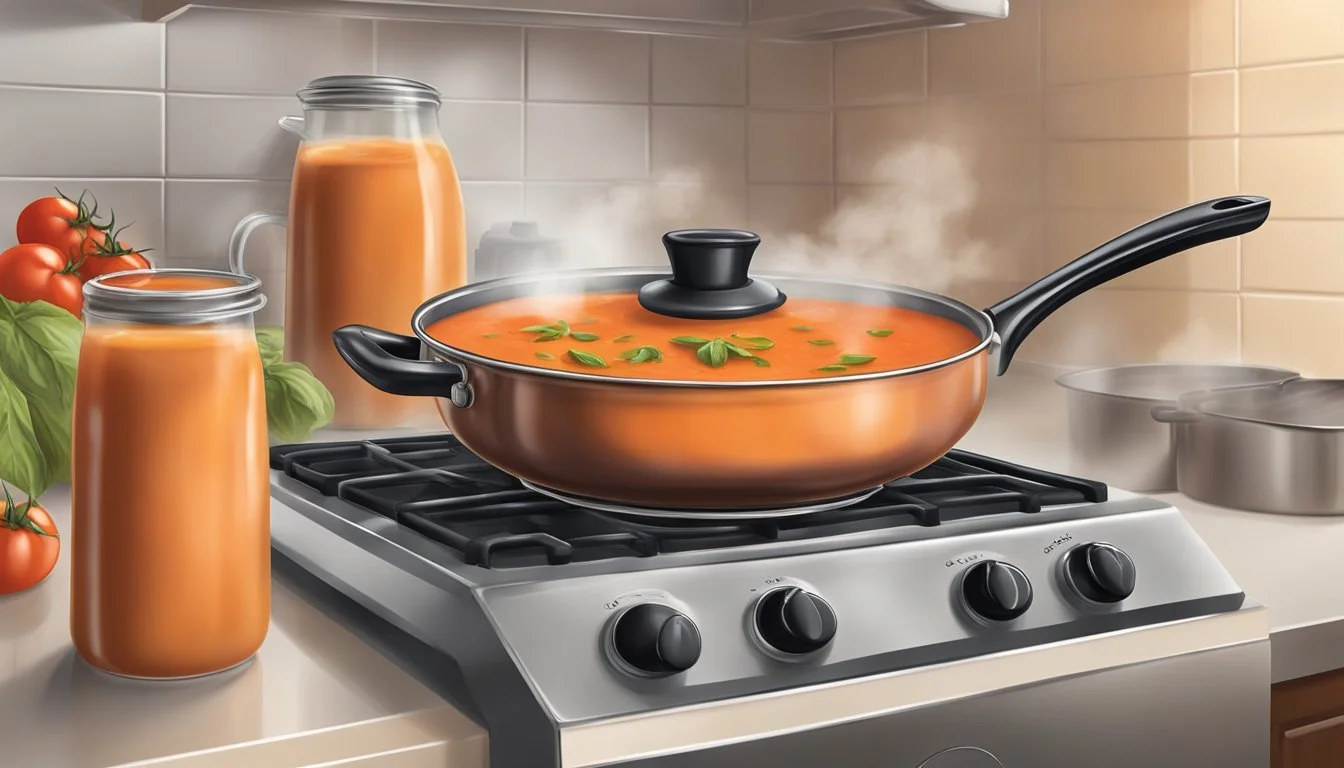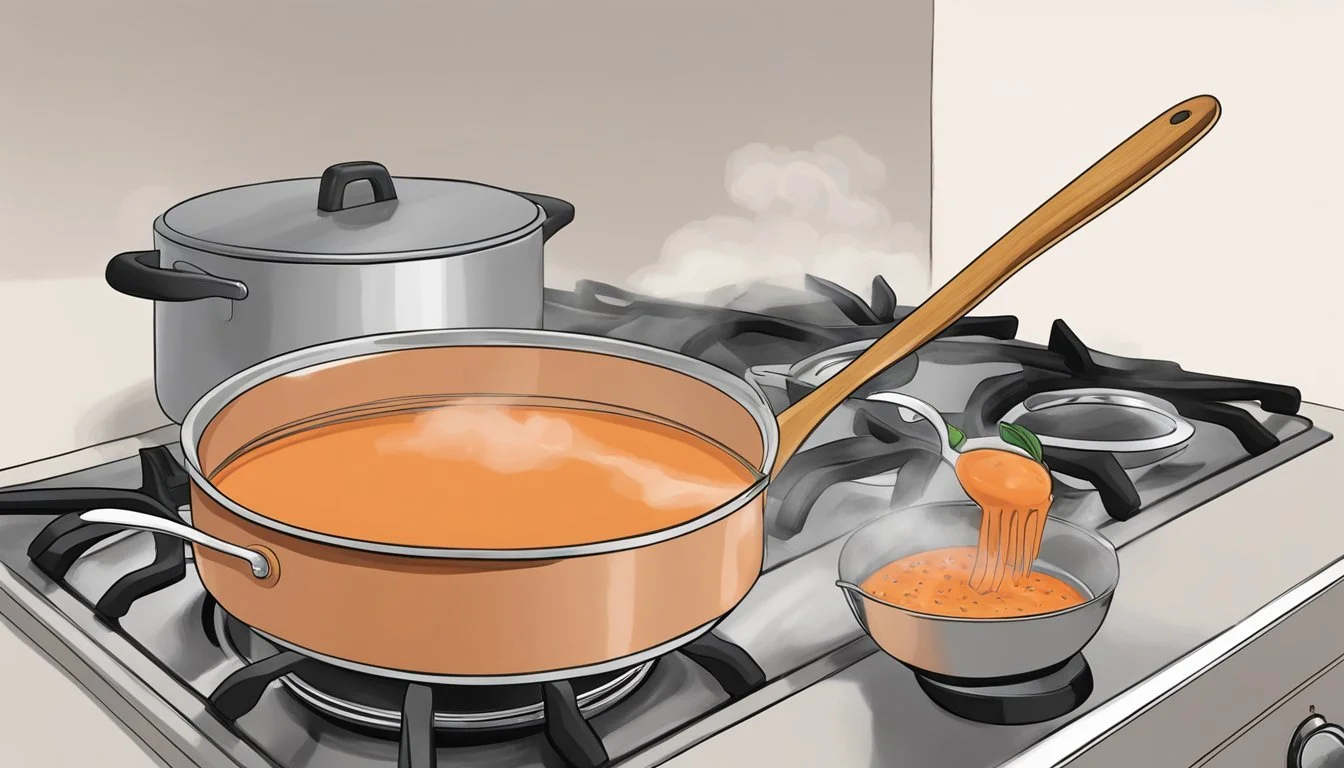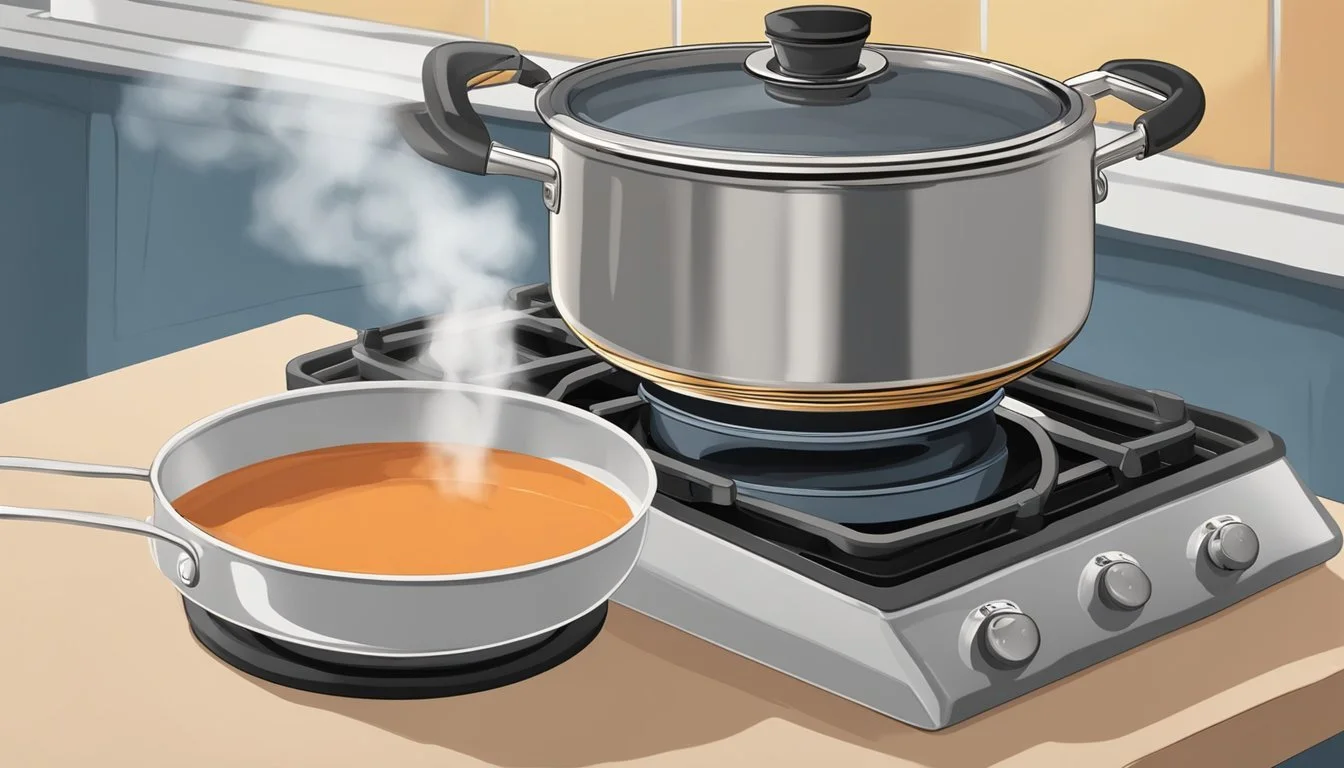Best Way to Reheat Tomato Bisque
Maintaining Creamy Quality and Comforting Flavor
Tomato bisque is a beloved dish, appreciated for its rich flavor and creamy consistency, making it a quintessential comfort food. The essence of this soup lies in its smooth texture and the balance of tangy tomatoes with the sweetness of cream and fragrances of herbs like basil. Heating tomato bisque properly is as important as its preparation because the right reheating technique can either enhance its flavors or led to a less favorable outcome.
Reheating tomato bisque requires careful attention to preserve its creamy texture and prevent separation. Factors such as the heating method, temperature, and even the choice of pot play a critical role in ensuring the bisque maintains its comforting taste. The goal is to achieve a temperature that is hot enough to make the soup enjoyable while not compromising the integrity of its ingredients.
To successfully reheat tomato bisque, it is essential to choose a method that gently warms the soup. Stovetop reheating, for example, allows for controlled heat and can help evenly distribute temperature throughout the bisque. Stirring frequently is paramount to avoid scorching and ensuring that the soup reaches a consistent warmth. It is important to avoid overheating, as this can cause the cream to separate and oils to surface, which detracts from the bisque's smooth, velvety character.
Understanding Tomato Bisque
Tomato Bisque is a sophisticated variation of the classic tomato soup, known for its creamy texture and rich flavor profile. This section delves into the key components that make this dish unique, the nutritional aspects, and its culinary origins.
Key Ingredients
Tomatoes: The foundation of the bisque, providing the dominant flavor and body.
Cream: Adds the creamy texture that differentiates bisque from standard soups (What wine goes well with soups?).
Broth: Often chicken or vegetable broth is used as a base to enhance depth.
Basil: A complementary herb that infuses an aromatic freshness to the bisque.
By focusing on high-quality tomatoes and combining them with a well-seasoned broth, the bisque achieves a balance of acidity and sweetness, which is then rounded out by the addition of cream.
Health and Nutrition
Tomato Bisque carries both the nutritive benefits of tomatoes and the indulgent attributes from the cream. Tomatoes offer:
Vitamins: A notable source of Vitamin C and Vitamin K.
Antioxidants: Contains lycopene, an antioxidant with potential health benefits.
The cream, while contributing to a higher calorie count, also provides a dose of calcium. Dietary preferences may lead to variations, such as using low-fat cream or cream substitutes to make the bisque more health-conscious.
The History of Tomato Bisque
The dish has roots in classic French cuisine, where "bisque" originally referred to a smooth, cream-based seafood soup. The adaptation using tomatoes likely emerged alongside the widespread culinary incorporation of tomatoes in North America and Europe. The exact origin is unclear, but it is an enduring staple of American comfort cuisine, emphasizing the rich and smooth tomato flavor such a soup is known for.
Preparing Tomato Bisque
Crafting a tomato bisque that boasts a creamy texture and a depth of flavor requires careful selection of ingredients and mastery of cooking techniques. Ensuring the bisque retains its heartwarming essence starts with the quality of tomatoes and extends to the method of simmering.
Selecting Tomatoes
Choosing the right type of tomato is crucial for a rich and flavorful bisque. Roma tomatoes are often recommended for their thick flesh and lower water content, which contributes to a concentrated tomato flavor. When available, opt for roasted tomatoes; their caramelization brings out a natural sweetness and adds a smoky undertone to the bisque. For a vegetarian bisque, ensure that all ingredients, such as the stock, are meat-free.
Recommended Types: Roma tomatoes, roasted tomatoes
Considerations: Vegetarian options (vegetable stock)
Cooking Techniques
The cooking process starts with heating olive oil in a saucepan, then sautéing onions, garlic, and celery until tender, which sets a flavorful base. Adding fresh or roasted tomatoes along with spices and allowing the mixture to simmer gently is key to melding the flavors. A low and slow simmer helps in reducing the bisque to the right consistency while infusing it with the delicate flavors of parsley and other chosen herbs.
Sauté: Onions, garlic, celery in olive oil
Simmer: With tomatoes, spices, and herbs for deep flavor infusion
Seasoning and Flavor Enhancements
When reheating tomato bisque, it's essential to not only restore its warmth but also ensure that the seasoning and flavor profiles are preserved or even enhanced. The focus here is on striking the perfect balance between herbs, spices, and seasoning to complement the creamy tomato foundation.
Optimizing Salt and Pepper Levels
To sustain the bisque's savory notes, one should adjust the levels of salt and black pepper after reheating. A pinch of salt can amplify the inherent flavors of the tomato, while freshly ground black pepper may introduce a subtle heat and complexity. Each addition should be made cautiously, tasting frequently to avoid overpowering the dish.
Utilizing Fresh Herbs
Incorporating fresh herbs such as basil and thyme can revitalize the bisque's aroma and taste. These herbs should be finely chopped and sprinkled gently over the bisque. Fresh basil leaves specifically can impart a bright, peppery flavor that pairs beautifully with the creamy tomato base.
Balancing Sweetness and Acidity
To counterbalance the bisque’s acidity, a modest sprinkle of sugar can be considered. This should be done sparingly, ensuring not to turn the bisque overly sweet. Conversely, a small dash of vinegar can be added to enhance the bisque's vivacity. Additionally, for a tingling warmth, a sprinkle of red pepper flakes may be invited into the fold, especially for palates favoring a spicy kick.
Creaminess Factors for Tomato Bisque
The creaminess of tomato bisque is a critical element in both its flavor and texture. Achieving the desired level of richness hinges on the choice of dairy inputs and thickening techniques used during preparation.
Cream Options
Heavy Cream: It provides a rich flavor and velvety texture. Adding heavy cream towards the end of reheating ensures the bisque maintains its luxurious mouthfeel.
Whole Milk: A lighter alternative to heavy cream, whole milk imparts a creamy consistency without excessive heaviness. For best results, one should incorporate it gradually and prevent it from boiling to avoid curdling.
Butter: When combined with flour, butter can enrich the bisque while also contributing to its thickening. A dollop of butter added at the last stage of reheating can also enhance gloss and flavor.
Parmesan Cheese: This cheese melts well, adding a nutty undertone and additional creaminess. It should be finely grated and stirred in until fully melted.
Thickening Agents
Roux: A mixture of equal parts flour and butter cooked together until reaching a desired color, roux serves as a classic thickening agent, contributing both to the structure and the creamy texture of the bisque.
Flour: When used in conjunction with butter, it forms the base for roux. One must whisk it thoroughly into the bisque to avoid lumps.
By paying attention to these factors and incorporating them appropriately, reheated tomato bisque can maintain its creamy and comforting taste.
Reheating Tomato Bisque
When reheating tomato bisque, it is essential to maintain its creamy texture without separating or scorching the soup. The goal is to warm the bisque evenly while preserving its comforting taste.
Stovetop Method
For the stovetop method, they should transfer the bisque into a saucepan and reheat it over a low to medium heat. Stirring occasionally, they should allow the bisque to reach a simmer but not a full boil, as high heat can affect the creaminess of the soup. The total time for reheating should typically not exceed 10 minutes to prevent overcooking.
Stock: If the bisque appears too thick, they can thin it with a small amount of chicken or vegetable stock.
Cream: A splash of cream can be added to the bisque to reintroduce richness if needed.
Microwave Method
If using a microwave, the bisque should be placed in a microwave-safe container. They should heat the bisque on medium power in short intervals, stirring in between each burst to ensure even heat distribution. This method can take between 2-4 minutes depending on the microwave and the quantity of soup.
To Avoid Splatter: Cover the container with a microwave-safe lid or paper towel.
Heating in stages: This ensures that the creamy texture is not compromised by overheating in one go.
Ensuring Even Heat Distribution
Even when reheating tomato bisque, ensuring that heat spreads uniformly throughout the soup is crucial to retain its texture and flavor.
Stirring: Constant attention and gentle stirring are key, particularly on the stovetop.
Temperature: Soup should be reheated gradually; quick and high heat can cause the creamy components to separate.
Additions: Adjusting the consistency with stock and reintroducing cream can help restore the original texture of the bisque.
Preserving the Quality of Tomato Bisque
Storing tomato bisque correctly is crucial for maintaining its creamy texture and rich flavor. Proper techniques can extend the bisque's shelf life, ensuring that its comforting taste is preserved for later enjoyment.
Proper Storage Techniques
To preserve tomato bisque, it should be cooled to room temperature as quickly as possible. Once cooled, it must be transferred to an airtight container to prevent the cream in the bisque from taking on any other flavors from the refrigerator. The bisque can be refrigerated for up to three days. To ensure freshness and prevent contamination, always use a clean spoon when serving the bisque.
Refrigeration:
Cool bisque to room temperature before refrigerating.
Transfer to an airtight container.
Store in the fridge for up to 3 days.
Freezing and Thawing Tips
Freezing tomato bisque can extend its life for up to six months. However, because the bisque contains cream, it's important to know that the cream may separate or grain when frozen. To reduce this risk, one should freeze the bisque in small portions and leave it to thaw slowly in the refrigerator for at least 12 hours before reheating.
Freezing:
Freeze in small portions for best results.
Use freezer-safe containers or bags.
Thawing:
Thaw the bisque in the refrigerator, not at room temperature.
Allow for a 12-hour thawing period.
It's recommended to gently reheat the bisque over low heat while stirring frequently to help re-emulsify the cream after freezing and thawing.
Pairing and Serving Suggestions
When serving reheated tomato bisque, the right pairings can enhance its creamy and comforting taste. Selecting the perfect accompaniments and presentation garnishes plays a crucial role in creating a culinary experience that accentuates the bisque's flavors.
Accompaniments
Pairing tomato bisque with the right side dish can transform it into a hearty meal. A classic option is the grilled cheese sandwich. The melted cheese and crispy bread offer a delightful contrast to the smooth texture of the bisque. For a lighter choice, one might opt for croutons; their crunch adds an enjoyable textural element to the soup.
Ideal Pairings Include:
Grilled cheese sandwich
Croutons
A slice of artisan bread
A sprinkle of grated parmesan
Presentation and Garnish
The visual appeal of tomato bisque is just as important as its taste. To garnish, a swirl of cream creates an inviting appearance, while a sprinkle of finely chopped basil adds a pop of color and fresh flavor. A touch of grated parmesan on top provides a savory note that complements the tomato base beautifully.
Suggested Garnishes:
Fresh basil
A swirl of cream
Grated parmesan
Variations of Tomato Bisque
Tomato Bisque can be adapted to suit various dietary needs and taste preferences. Below, the section explores both diet-specific alternatives and international twists, ensuring there's a version of this comforting soup for everyone.
Diet-Specific Alternatives
Vegan: Traditional recipes include dairy, but a vegan Tomato Bisque can be created by substituting animal products with plant-based alternatives. Using vegetable broth as the base, one can add creaminess with coconut milk, a common dairy substitute that maintains a creamy texture. For a rich flavor, San Marzano tomatoes are an excellent choice due to their robust taste and low acidity.
Vegetarian: A vegetarian variation might stick with the classic creamy tomato basil bisque while ensuring that the broth is vegetable-based. Substitutions include using vegetarian parmesan cheese and heavy cream alternatives, such as soy or almond cream.
International Twists
Chicken: For those who prefer a non-vegetarian soup, adding chicken broth as the base and incorporating chunks of cooked chicken breast can enhance the bisque with a savory depth.
Seafood: Seafood lovers might enjoy a bisque that incorporates elements from a traditional seafood chowder. Adding shrimp, crab, or lobster to the tomato base creates a luxurious and satisfying meal.
Tips and Tricks for Perfect Tomato Bisque
To achieve the perfect Tomato Bisque, one must pay attention to the cooking consistency, select complementary flavors, and understand proper storage methods. These strategies ensure a bisque that is not only comforting but also boasts a creamy texture and a rich taste.
Cooking Consistency
When it comes to Tomato Bisque, consistency is key. For a smooth and velvety soup, it's crucial to puree the soup thoroughly. An immersion blender provides the best control and ease for this task, though a regular blender or food processor can also be effective. Ensure that all elements are well-blended, allowing the cream and tomatoes to marry into the ideal creamy richness. If the bisque is too thick, a bit of chicken stock can help thin it out.
Flavor Pairing
Tomato Bisque's flavor can be enhanced with the right pairings. Consider adding a touch of sweetness to balance the acidity of the tomatoes, and fresh thyme for an aromatic depth. A hint of spice can be achieved with a dash of cayenne pepper, making the bisque pleasantly spicy without overpowering it. For those who don't have fresh herbs on hand, dried basil can be an effective substitute, but note that dried herbs are more concentrated in flavor, so use them sparingly.
Sweet: A pinch of sugar
Herbs: Fresh thyme or dried basil
Spice: Cayenne pepper
Making Ahead and Storage
Tomato Bisque can be made ahead with ease, provided proper storage techniques are employed. To maintain its creamy texture, cool the bisque before transferring it to an airtight container; this will prevent condensation that can affect its consistency upon reheating. The bisque can be refrigerated for up to four days. If using canned tomatoes, ensure they're of high quality, as they will be the base of your bisque's flavor when not using fresh tomatoes. Prep time and cook time are critical for meal planning; expect about 10-15 minutes prep and at least 30 minutes of cook time to develop flavors fully.
Frequently Asked Questions
When seeking to maintain the creamy and comforting taste of tomato bisque during reheating, certain questions frequently arise. Below is a compilation of common inquiries with straightforward solutions to ensure the bisque retains its intended flavor and texture.
Ingredient Substitutes
People often wonder about substituting ingredients to either accommodate dietary restrictions or personal preferences. Here are specific ingredient substitutes related to tomato bisque:
Cream: Heavy whipping cream can be replaced by half-and-half for a lighter bisque.
Half-and-Half: For a dairy-free option, one may use coconut cream or almond milk though the taste profile will change slightly.
Sweet Onion: Shallots can be used as an alternative to sweet onion, providing a similar but slightly more intense flavor.
Parmesan: While Parmesan is a popular garnish, other hard aged cheeses like Asiago or Pecorino Romano can be used for a similar nutty flavor.
Bacon: For a vegetarian option, smoked paprika can offer a similar smoky essence without using bacon.
Reheating Queries
The proper reheating method is crucial for preserving the bisque's quality. Here are some points addressing reheating concerns:
Slow Cooker: A slow cooker can gently reheat tomato bisque on a low setting, but one should stir occasionally to maintain even temperature.
Dutch Oven: Using a dutch oven over low to medium heat is ideal for reheating, as it distributes heat evenly and prevents the soup from burning.
Microwave: If using a microwave, it's best to cover the bisque and reheat in short intervals, stirring in between to avoid hot spots.
Texture and Consistency Issues
Maintaining the creamy consistency is another common concern. The texture of tomato bisque may change upon reheating due to several factors:
Immersion Blender: If the bisque separates or becomes grainy, using an immersion blender can help restore its smooth texture.
Thickness: If the bisque is too thick after reheating, one can add a little bit of broth or water to adjust the consistency.
Stirring: Continuous stirring while reheating can prevent the bisque from sticking to the bottom and help maintain an even consistency.






